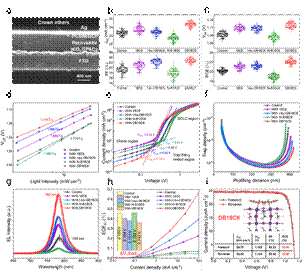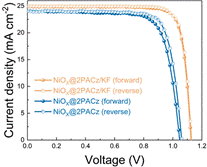Currently, both perovskite thin-film solar cells and perovskite/silicon tandem solar cells, have entered the initial stage of industrialization. Despite meeting industrial efficiency requirements, further improving the efficiency and stability of perovskite solar cells remains a focal point of research.
Recently, Associate Prof. Tang Zeguo from College of New Materials and New Energy at Shenzhen Technology University (SZTU) and his research team, in collaboration with Prof. Yan Hui, Prof. Zhang Yongzhe, and Prof. Zheng Zilong from College of Material Science and Engineering at Beijing University of Technology and their research teams, along with Gold Stone (Fujian) Energy Company Limited, have made a series of breakthroughs in efficiency and stability of perovskite solar cells, and three-terminal all perovskite tandem solar cells, with their research findings published in internationally renowned journals.
01 Understanding the Role of Crown Ether Functionalization in Inverted Perovskite Solar Cells
Inverted perovskite solar cells with a p-i-n structure have attracted significant interest due to their high efficiency, long-term stability, and cost reduction potential. To address the challenge of defect-related nonradiative recombination, Associate Prof. Tang Zeguo in collaboration with Prof. Zheng Zilong and their research teams improved the passivation at the interface between the perovskite layer and electron transfer layer using crown ether derivatives. Through a comprehensive approach involving first-principles calculations, photoluminescence (PL) and time-resolved photoluminescence (TRPL) spectra, and grazing-incidence wide-angle X-ray scattering (GIWAXS) analysis, the research team elucidated the passivation mechanism, which led to an efficiency of 23.3% in NiOx-based p-i-n PSCs, thereby reducing nonradiative recombination with 25% of the voltage losses. Additionally, the unencapsulated PSCs maintained 92% of their initial efficiency after 1224 h of aging, showcasing remarkable long-term stability. The inverted structure with interfacial passivation has great potential for high-efficiency and stable PSC designs, thereby advancing the commercialization of PSCs.

(a) Cross-sectional SEM image of the inverted PSC; (b-c) parameter of perovskite solar cells (e) space charge limited current (SCLC) on electron-only device (FTO/SnO2/perovskite/PCBM/BCP/Ag) under dark conditions; (f) spatial distribution of defects via DLCP measurements; (g) EL spectra at 1.2 V and (h) EQEEL spectra of control and crown ether-treated devices, while the inset figure shows the ΔV3 loss of PSCs. (i) J–V curve of the best-performing (DB18C6-treated) device under simulated AM 1.5G sunlight [Photo/https://pubs.acs.org/doi/full/10.1021/acsenergylett.3c02322]
The research teams published an article titled “Understanding the Role of Crown Ether Functionalization in Inverted Perovskite Solar Cells” in ACS Energy Letters (IF: 22.0), which is a top journal in the fields of energy research. SZTU is the first affiliation. Sui Yujie and Zhou Wencai, exchange graduate students from College of New Materials and New Energy at SZTU are the first authors. Associate Prof. Tang Zeguo is the first corresponding author and Prof. Zheng Zilong is the co-corresponding author. Chair Prof. Han Peigang, Assistant Prof. Danish Khan, Assistant Prof. Tang Jun, and Assistant Prof. Yang Fan from College of New Materials and New Energy at SZTU are co-authors. This research has been funded by intergovernmental international scientific and technological innovation cooperation project from the National Key Research and Development Program of China and the startup funding project for top talents at SZTU.
02 Ion‐Dipole Interaction for Self‐Assembled Monolayers: A New Strategy for Buried Interface in Inverted Perovskite Solar Cells
Nickel oxide (NiOX) is important in improving the efficiency and stability of p-i-n inverted perovskite solar cells (PSCs), showing strong potential for commercial use. However, enhancing contact passivation between perovskites and NiOX poses a challenge due to a blocked buried interface. To tackle this issue, Associate Prof. Tang Zeguo from SZTU in collaboration with Prof. Zheng Zilong and Prof. Zhang Yongzhe from Beijing University of Technology and their research teams discovered that self-assembled monolayers (SAMs) can be utilized as a buffer layer to prevent direct contact and non-radiative recombination. The large dipole moment of SAMs raises the work function of NiOX, which is important to boost hole transport efficiency, given the low potential barrier at the hole transfer interface. Through a combination of first-principles calculations, drive-level capacitance profiling, and transient absorption spectrum characterization, insights into ion-dipole interactions and the interface passivation mechanism of a potassium fluoride (KF) ultra-thin buffer layer between SAMs and perovskites are provided. This approach has led to achieving an impressive efficiency of up to 23.25% in inverted PSCs, with unencapsulated devices maintaining 90% of their initial efficiency even after 1400 hours of aging under nitrogen, showcasing remarkable long-term stability. This innovative strategy highlights the importance of the SAMs dipole moment at the NiOx/perovskites interface and presents a new method on solving buried interfaces for high efficiency and long-term stability in inverted PSCs.


Illustration of the mechanism of passivation of reactive ions at buried interfaces and I-V curves with or without potassium fluoride (KF) ultra-thin buffer layer [Photo/https://onlinelibrary.wiley.com/doi/epdf/10.1002/adfm.202316202]
An article titled “Ion-Dipole Interaction for Self-Assembled Monolayers: A New Strategy for Buried Interface in Inverted Perovskite Solar Cells” was published in Advanced Functional Materials (IF19.0), which is the part of the prestigious Advanced portfolio and a top-tier materials science journal. SZTU is the first affiliation. Wang Shuanglin, exchange graduate students from College of New Materials and New Energy at SZTU and Assistant Prof. Danish Khan from College of New Materials and New Energy at SZTU are the co-first authors. Associate Prof. Tang Zeguo is the first corresponding author. Prof. Zheng Zilong and Prof. Zhang Yongzhe are the co-corresponding authors. Chair Prof. Han Peigang, Assistant Prof. Tang Jun, and Assistant Prof. Yang Fan from College of New Materials and New Energy at SZTU are co-authors. This research has been funded by intergovernmental international Scientific and technological Innovation cooperation project from the National Key Research and Development Program, the startup funding project for top talents at SZTU, and Shenzhen higher education institutions' stable support plan.
03 Design of Efficient Inverted NiOX-Based Three-Terminal Back-Contact All Perovskite Tandem Solar Cells
The development of efficient all perovskite tandem solar cells has encountered challenges related to current matching and optical losses. Associate Prof. Tang Zeguo in collaboration with Prof. Zheng Zilong and their research teams proposed a design of a non-coplanar three-terminal (3T) all perovskite tandem solar cell. It comprises a p-i-n inverted NiOX-based CsPbI2Br perovskite top cell and a FA0.6MA0.4Sn0.5Pb0.5I3 perovskite bottom cell with a back-contact (BC) device structure. This design successfully reduces optical losses in non-absorbing layers, leading to a 2.9% absolute efficiency improvement compared to that of planar sandwich-type 3T tandems. The optical and electrical characteristics of the multi-terminal tandem cells are analyzed. The focus then shifts to understanding how the thickness of the top cell affects the overall performance of the non-coplanar BC 3T-tandem, considering low-energy photon optical reflection and carrier transport distance. By optimizing energy levels and device structure, an efficiency of 32.16% is achieved using the non-coplanar BC 3T device architecture. The top cell includes a hole extraction layer (ITO/NiOx), CsPbI2Br absorber layer, and electron extraction layer (ZnO/FA0.6MA0.4Sn0.5Pb0.5I3/SnO2/Ag). The bottom cell consists of Ni/NiOx/FA0.6MA0.4Sn0.5Pb0.5I3/SnO2/Ag, where the bottom perovskite layer has two functions: electron transport for the top cell and low-energy photons absorption layer in the bottom cell. This study offers valuable insights and a promising approach for producing highl-efficient all perovskite tandem solar cells.

(a) Two-terminal; (b) three-terminal; (c) four-terminal all perovskite tandem solar cell and I-V curve [Photo/https://onlinelibrary.wiley.com/doi/full/10.1002/adfm.202401508]
An article titled “Design of Efficient Inverted NiOX-Based Three-Terminal Back-Contact All Perovskite Tandem Solar Cells” was published in Advanced Functional Materials (IF19.0). SZTU is the first affiliation. Yang Xiqi, exchange graduate student from College of New Materials and New Energy at SZTU is the co-first author. Associate Prof. Tang Zeguo is the corresponding author. Prof. Zheng Zilong and Chen Xiaoqing, Associate Fellow from Beijing University of Technology are co-corresponding authors.
Currently, College of New Materials and New Energy at SZTU has produced a series of research achievements in the field of photovoltaic cell energy, with most articles published in internationally renowned journals on photovoltaic cells and materials. Expectations are high for the early realization and industrial development of related research results to support the country’s achievement of the “dual carbon” goals.
Drafted by Christine(黄昭萱)/ International Cooperation & Student Affairs Office
Revised by International Cooperation & Student Affairs Office
Edited by International Cooperation & Student Affairs Office
